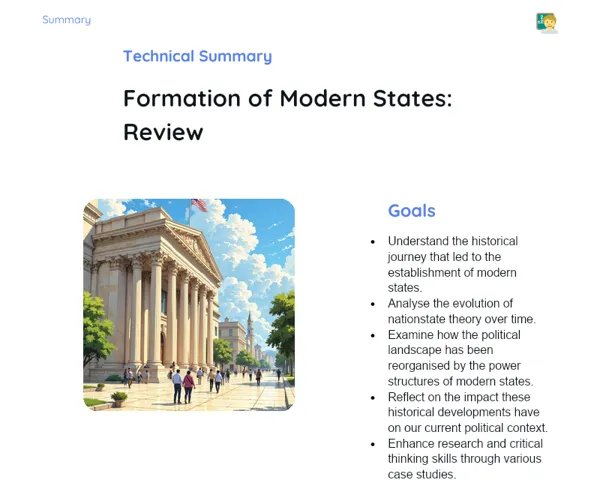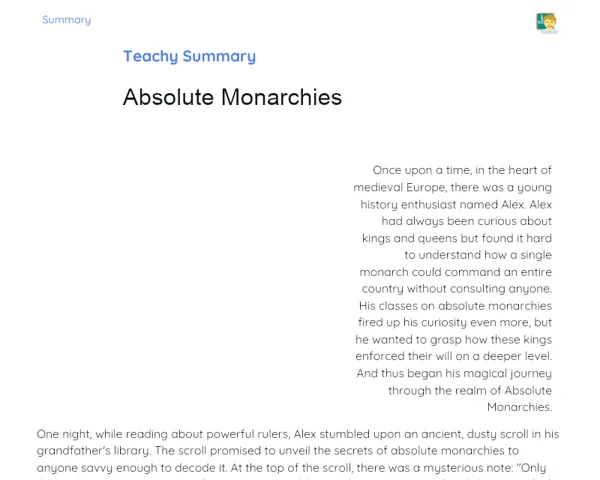Goals
1. Understand how Rome transitioned from a monarchy to a republic, looking at the political, social, and economic factors involved.
2. Identify significant historical figures and key events that defined the Roman monarchy and the republic.
3. Examine the background of the Roman Empire, focusing on cultural influences and structural changes.
4. Develop skills to connect historical events with their impacts on the present.
5. Encourage collaboration through group activities.
Contextualization
The shift from monarchy to republic in Rome is a captivating chapter in ancient history. This pivotal moment not only changed the trajectory of the city-state but also had a lasting impact on the evolution of political systems throughout the Western world. The transformation was marked by power struggles, significant political and social reforms, and the emergence of key figures such as Romulus, Tarquin the Proud, and Brutus. The establishment of the Roman Senate and Roman Assemblies laid the foundation for many of the political structures we recognise today, including modern parliaments.
Subject Relevance
To Remember!
Foundation of Rome and Roman Monarchy
The founding of Rome is credited to Romulus in 753 BC, marking the start of the Roman Monarchy, which persisted until 509 BC. During this time, Rome was under the rule of kings with absolute power, although they were assisted by a Senate composed of aristocrats. This era laid the socio-political and cultural groundwork that would shape the future of Rome.
-
Romulus is acknowledged as the founder and first king of Rome.
-
The Roman Monarchy lasted from 753 BC to 509 BC.
-
Kings wielded absolute powers but were counselled by the Senate.
-
Roman society started to form distinct social classes, consisting of patricians (aristocrats) and plebeians (commoners).
-
Prominent kings included Romulus, Numa Pompilius, and Tarquin the Proud.
Transition to the Roman Republic
Rome's transition from a monarchy to a republic was sparked by a revolt against the last king, Tarquin the Proud, who ruled with an iron fist. In 509 BC, Rome became a republic, creating a political structure that distributed power among various bodies, such as the Consuls, the Senate, and the Assemblies. This shift allowed for broader political involvement and marked the beginning of territorial expansion and social reforms.
-
The change occurred in 509 BC following the overthrow of Tarquin the Proud.
-
The Roman Republic established a government system with Consuls, the Senate, and Assemblies.
-
Consuls were elected each year and held executive authority.
-
The Senate, mainly comprising aristocrats, wielded considerable influence over policies and decisions.
-
The Assemblies provided a platform for citizen participation in politics, though inequalities remained.
Political Institutions of the Roman Republic
The Roman Republic featured a complex system of political institutions that ensured both the distribution of power and citizen participation. Central to this system were the Consuls, the Senate, and the Assemblies. The Consuls enforced laws and managed state affairs, while the Senate served as a powerful advisory body. The Assemblies were where citizens voted on laws and elected magistrates.
-
Consuls were two magistrates elected annually with executive powers.
-
The Senate comprised aristocrats and had considerable sway over political decisions.
-
The Assemblies were democratic entities where citizens voted on legislation and chose magistrates.
-
Other significant offices included the Tribunes of the Plebs, who advocated for the plebeians' interests.
-
The Roman Republic encouraged greater political engagement, even with disparities between patricians and plebeians.
Practical Applications
-
Tourism professionals can design educational itineraries that delve into the history of Rome, spotlighting key historical sites and events from the monarchy to the republic.
-
Heritage managers apply their understanding of Roman political institutions to conservate and communicate the significance of Rome's archaeological and historical sites.
-
Educators can weave Ancient Rome's history into their teaching to illustrate the evolution of political frameworks and the need for citizen engagement in governance.
Key Terms
-
Roman Monarchy: The period in Rome's history governed by kings (753 BC - 509 BC).
-
Roman Republic: The political system that emerged after the monarchy's fall, defined by a distribution of power among various entities (509 BC - 27 BC).
-
Senate: The political institution made up of aristocrats with significant influence in the Roman Republic.
-
Consuls: The magistrates elected each year in the Roman Republic who held executive powers.
-
Assemblies: Democratic bodies where Roman citizens voted on laws and selected magistrates.
Questions for Reflections
-
In what ways did the shift from monarchy to republic in Rome shape the political frameworks we know today?
-
How do the political institutions of the Roman Republic compare and contrast with modern governance systems?
-
How can studying Ancient Rome facilitate the development of more informed and engaged citizens in today's society?
Debate on Roman Influence on Modern Political Structures
Organise a group debate focusing on how the political institutions of the Roman Republic have influenced today's political landscape and the lessons we can apply in the present context.
Instructions
-
Split into groups of 4 to 5 students.
-
Each group should select a political institution from the Roman Republic (Senate, Consuls, Assemblies) and research its roles and significance.
-
Prepare a presentation on how this institution has shaped modern political structures.
-
Present findings to the class and engage in dialogue regarding similarities and differences with contemporary institutions.
-
Discuss how the lessons learned can be utilised to enhance governance in today's world.


